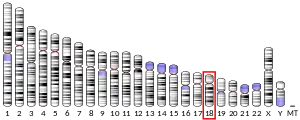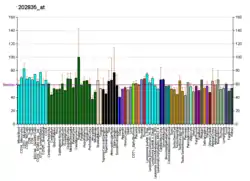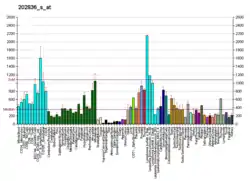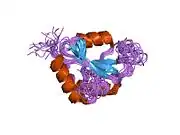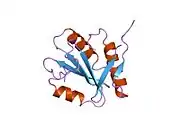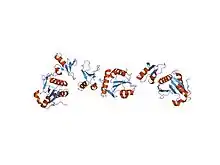| TXNL4A | |||||||||||||||||||||||||||||||||||||||||||||||||||
|---|---|---|---|---|---|---|---|---|---|---|---|---|---|---|---|---|---|---|---|---|---|---|---|---|---|---|---|---|---|---|---|---|---|---|---|---|---|---|---|---|---|---|---|---|---|---|---|---|---|---|---|
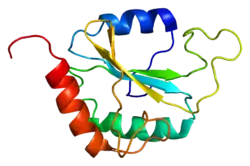 | |||||||||||||||||||||||||||||||||||||||||||||||||||
| |||||||||||||||||||||||||||||||||||||||||||||||||||
| Identifiers | |||||||||||||||||||||||||||||||||||||||||||||||||||
| Aliases | TXNL4A, DIB1, DIM1, HsT161, SNRNP15, TXNL4, U5-15kD, BMKS, thioredoxin like 4A | ||||||||||||||||||||||||||||||||||||||||||||||||||
| External IDs | OMIM: 611595 MGI: 1351613 HomoloGene: 7150 GeneCards: TXNL4A | ||||||||||||||||||||||||||||||||||||||||||||||||||
| |||||||||||||||||||||||||||||||||||||||||||||||||||
| |||||||||||||||||||||||||||||||||||||||||||||||||||
| |||||||||||||||||||||||||||||||||||||||||||||||||||
| |||||||||||||||||||||||||||||||||||||||||||||||||||
| Wikidata | |||||||||||||||||||||||||||||||||||||||||||||||||||
| |||||||||||||||||||||||||||||||||||||||||||||||||||
Thioredoxin-like protein 4A is a protein that is encoded by the TXNL4A gene in humans.[4][5]
Interactions
References
- 1 2 3 GRCh38: Ensembl release 89: ENSG00000141759 - Ensembl, May 2017
- ↑ "Human PubMed Reference:". National Center for Biotechnology Information, U.S. National Library of Medicine.
- ↑ "Mouse PubMed Reference:". National Center for Biotechnology Information, U.S. National Library of Medicine.
- ↑ Zhang YZ, Gould KL, Dunbrack RL JR, Cheng H, Roder H, Golemis EA (October 2000). "The evolutionarily conserved Dim1 protein defines a novel branch of the thioredoxin fold superfamily". Physiol Genomics. 1 (3): 109–18. doi:10.1152/physiolgenomics.1999.1.3.109. PMID 11015569. S2CID 16086223.
- ↑ "Entrez Gene: TXNL4A thioredoxin-like 4A".
- ↑ Zhang Y, Lindblom T, Chang A, Sudol M, Sluder AE, Golemis EA (October 2000). "Evidence that dim1 associates with proteins involved in pre-mRNA splicing, and delineation of residues essential for dim1 interactions with hnRNP F and Npw38/PQBP-1". Gene. 257 (1): 33–43. doi:10.1016/S0378-1119(00)00372-3. PMID 11054566.
Further reading
- Reuter K, Nottrott S, Fabrizio P, Lührmann R, Ficner R (2000). "Identification, characterization and crystal structure analysis of the human spliceosomal U5 snRNP-specific 15 kD protein". J. Mol. Biol. 294 (2): 515–25. doi:10.1006/jmbi.1999.3258. PMID 10610776.
- Zhang Y, Lindblom T, Chang A, Sudol M, Sluder AE, Golemis EA (2001). "Evidence that dim1 associates with proteins involved in pre-mRNA splicing, and delineation of residues essential for dim1 interactions with hnRNP F and Npw38/PQBP-1". Gene. 257 (1): 33–43. doi:10.1016/S0378-1119(00)00372-3. PMID 11054566.
- Zhang YZ, Cheng H, Gould KL, Golemis EA, Roder H (2003). "Structure, stability, and function of hDim1 investigated by NMR, circular dichroism, and mutational analysis". Biochemistry. 42 (32): 9609–18. doi:10.1021/bi034486i. PMID 12911302.
- Laggerbauer B, Liu S, Makarov E, Vornlocher HP, Makarova O, Ingelfinger D, Achsel T, Lührmann R (2005). "The human U5 snRNP 52K protein (CD2BP2) interacts with U5-102K (hPrp6), a U4/U6.U5 tri-snRNP bridging protein, but dissociates upon tri-snRNP formation" (PDF). RNA. 11 (5): 598–608. doi:10.1261/rna.2300805. PMC 1370748. PMID 15840814.
- Rual JF, Venkatesan K, Hao T, Hirozane-Kishikawa T, Dricot A, Li N, Berriz GF, Gibbons FD, Dreze M, Ayivi-Guedehoussou N, Klitgord N, Simon C, Boxem M, Milstein S, Rosenberg J, Goldberg DS, Zhang LV, Wong SL, Franklin G, Li S, Albala JS, Lim J, Fraughton C, Llamosas E, Cevik S, Bex C, Lamesch P, Sikorski RS, Vandenhaute J, Zoghbi HY, Smolyar A, Bosak S, Sequerra R, Doucette-Stamm L, Cusick ME, Hill DE, Roth FP, Vidal M (2005). "Towards a proteome-scale map of the human protein-protein interaction network". Nature. 437 (7062): 1173–8. Bibcode:2005Natur.437.1173R. doi:10.1038/nature04209. PMID 16189514. S2CID 4427026.
- Jin T, Guo F, Wang Y, Zhang YZ (2007). "Identification of human dim1 as a peptidase with autocleavage activity". Chemical Biology & Drug Design. 68 (5): 266–72. doi:10.1111/j.1747-0285.2006.00447.x. PMID 17177886. S2CID 13020526.
This article is issued from Wikipedia. The text is licensed under Creative Commons - Attribution - Sharealike. Additional terms may apply for the media files.
